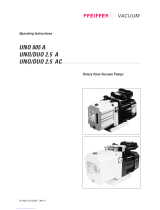
A419-00-880 Issue F
Page ii © Edwards Limited 2007. All rights reserved.
Edwards and the Edwards logo are trademarks of Edwards Limited.
Contents
5.3 Start-up ..................................................................................................................52
5.4 Manual shut-down ......................................................................................................53
5.5 Status and fault indications ...........................................................................................53
5.6 Unplanned shutdown and alarms .....................................................................................53
6 Maintenance ..................................................................................... 55
6.1 Safety ..................................................................................................................... 56
6.2 Maintenance plan .......................................................................................................56
6.3 Inspect the pipelines and connections ..............................................................................57
6.4 Cleaning the pump ......................................................................................................57
6.5 Service the EPX pump ..................................................................................................58
6.6 Fault finding .............................................................................................................59
7 Storage and disposal ........................................................................... 61
7.1 Storage ...................................................................................................................61
7.2 Disposal ................................................................................................................... 62
8 Service, spares and accessories .............................................................. 63
8.1 Introduction .............................................................................................................63
8.2 Service .................................................................................................................... 63
Index .............................................................................................. 65
For return of equipment, complete the HS Forms at the end of this manual.
Illustrations
Figure Page
1 Process compatibility chart ............................................................................................ 2
2 The EPX L dry vacuum pump ........................................................................................... 5
3 EPX twin 180L installation details - position of additional exhaust port for EPX twin variants ............. 6
4 EPX L labels (refer to Table 3) ......................................................................................... 8
5 EPX E dry pump .........................................................................................................10
6 EPX N series dry pump .................................................................................................11
7 End User Controller (EUC) display ....................................................................................12
8 Speed curve (mbar - Pa) ...............................................................................................18
9 Speed curve (Torr) ......................................................................................................18
10 Speed curve (mbar - Pa) EPX and EPX Twin ........................................................................19
11 Speed curve (Torr) EPX and EPX Twin ...............................................................................19
12 EPX L installation dimensions (EPX500L shown) ....................................................................20
13 EPX LE installation dimensions (EPX500LE shown) .................................................................21
14 EPX N installation dimensions (EPX500N shown) ...................................................................22
15 EPX NE installation dimensions (EPX500NE shown) ................................................................ 23
16 Location of the pump centre of gravity from centre of the top of the inlet flange ..........................24
17 Gas module schematic .................................................................................................25
18 Schematic diagram of emergency stop facility ....................................................................32
19 EUC and PDT menu logic ...............................................................................................41
20 Switch on menu .........................................................................................................42
21 Switch off menu .........................................................................................................42
22 Normal menu ............................................................................................................43
23 Status menu .............................................................................................................44
24 Control menu ............................................................................................................45
25 Setup menu (sheet 1 of 2) .............................................................................................46
26 Software version ........................................................................................................48
27 Select units menu .......................................................................................................49




















